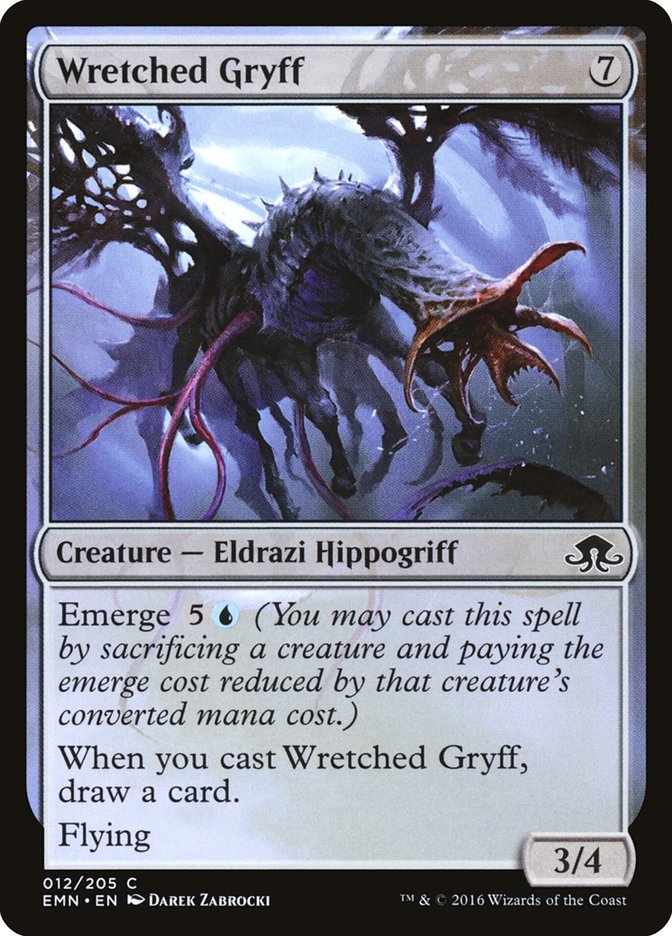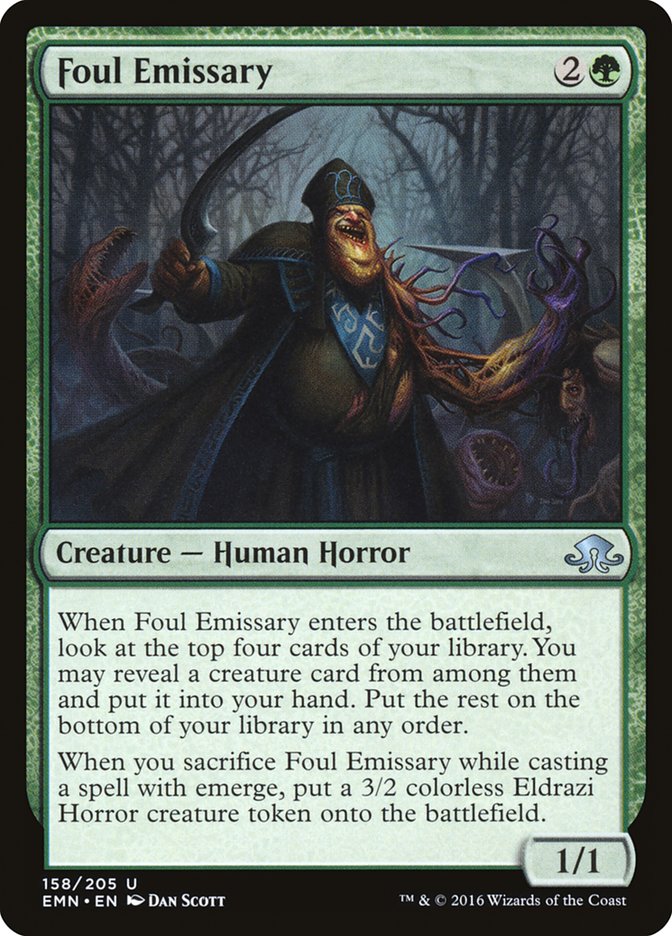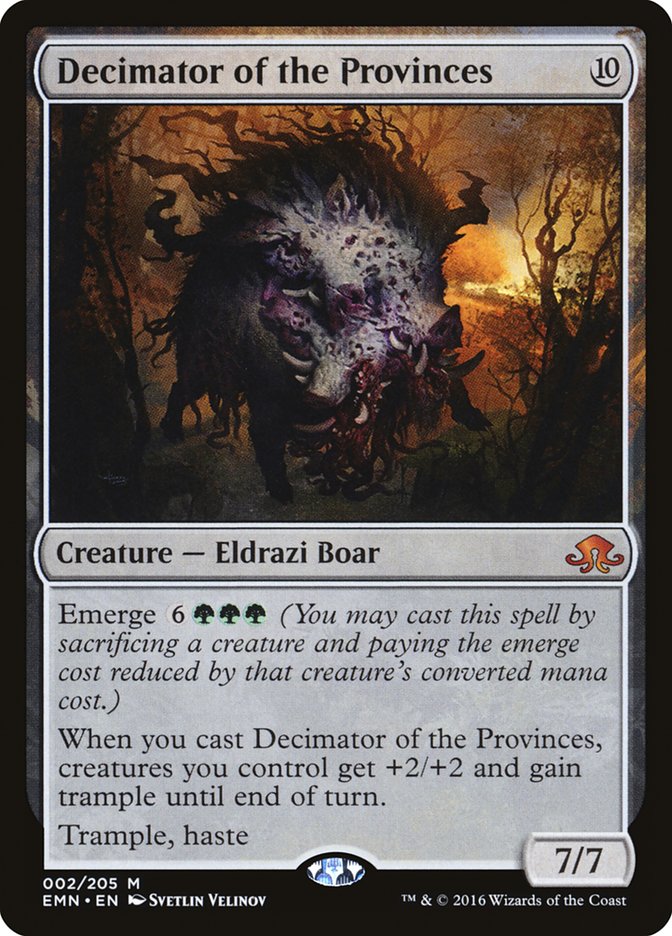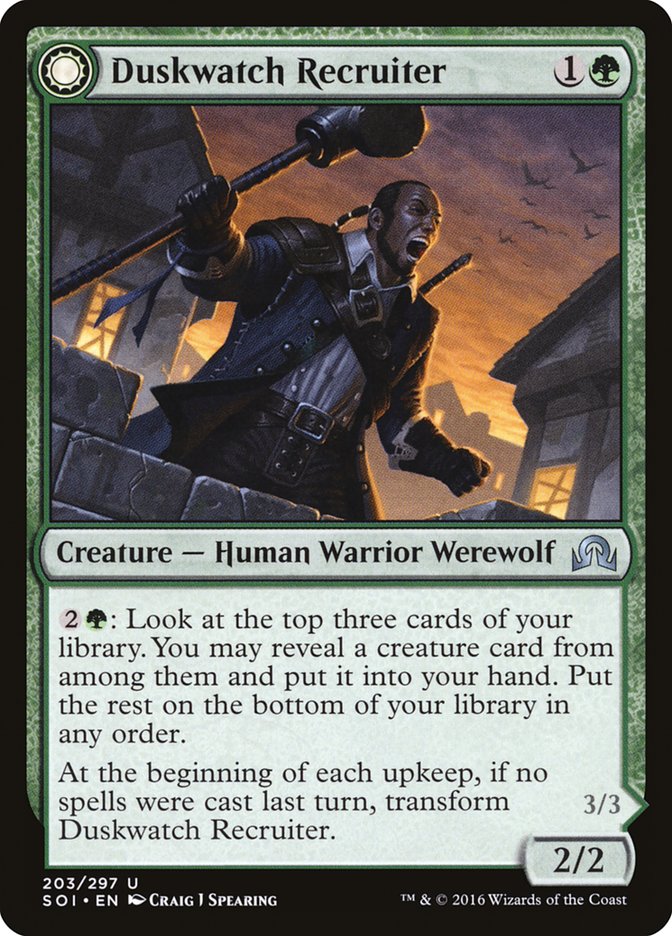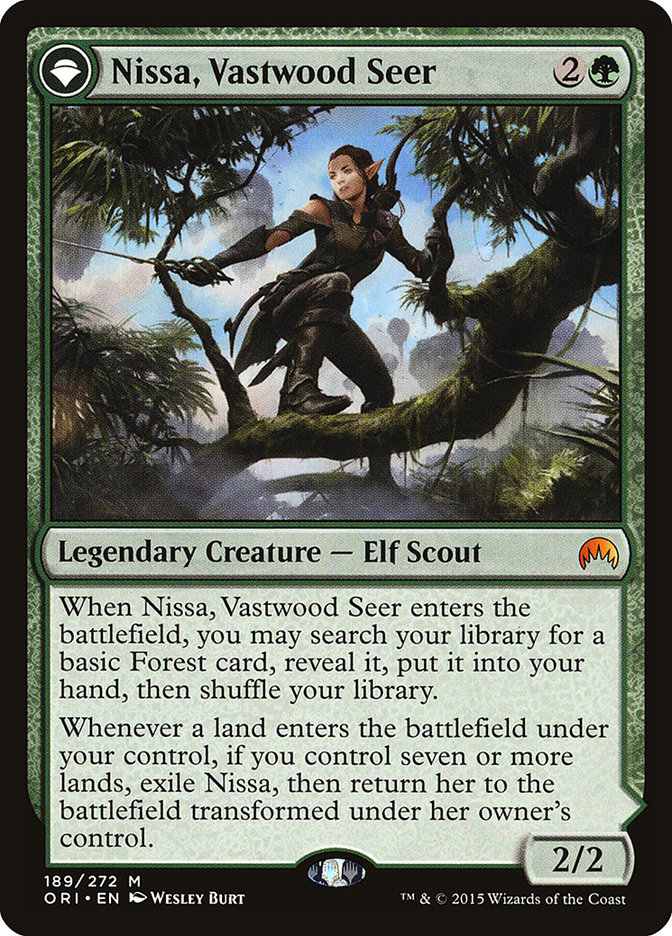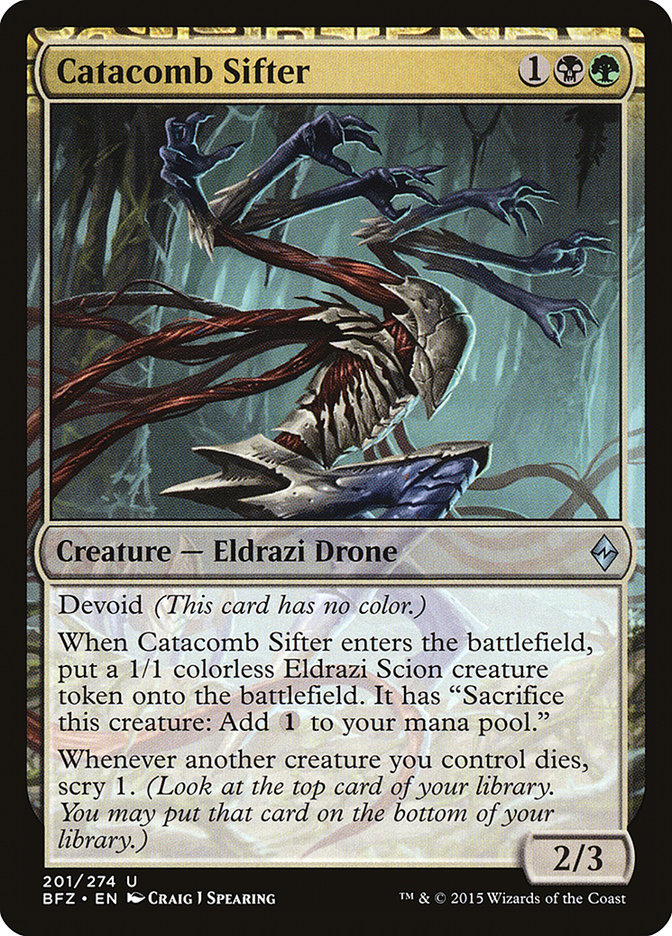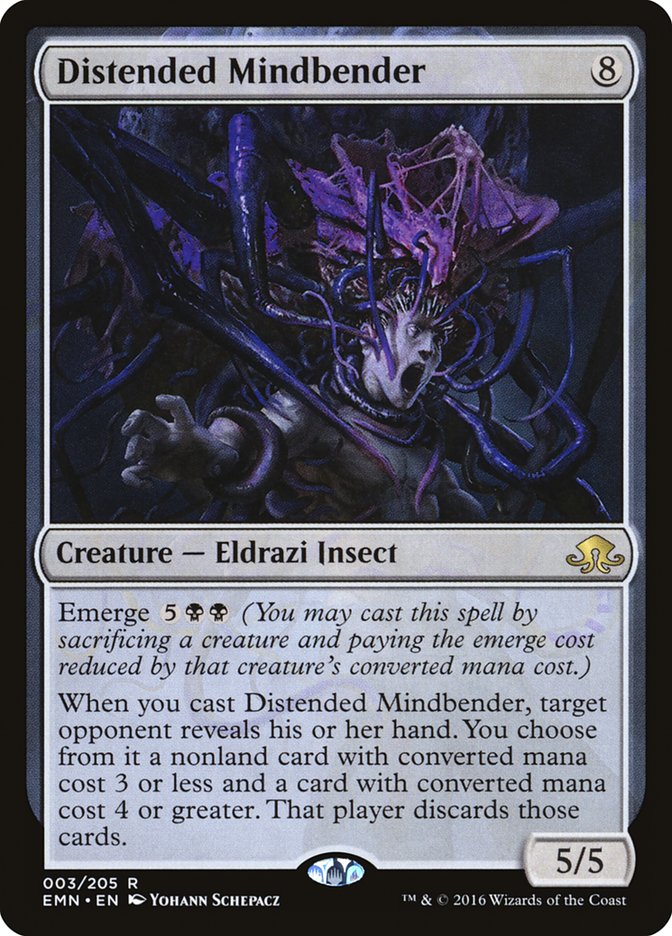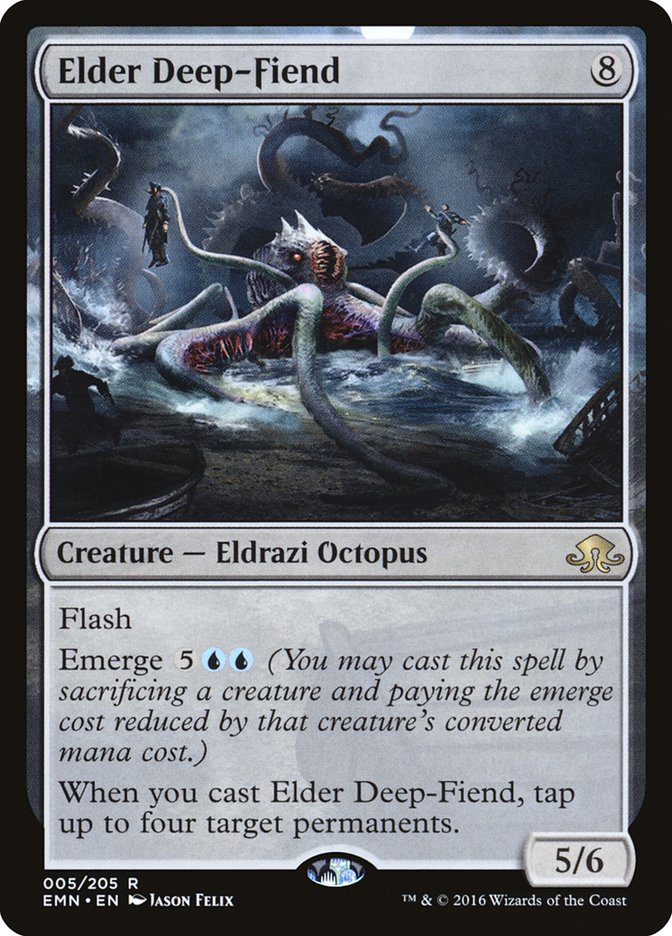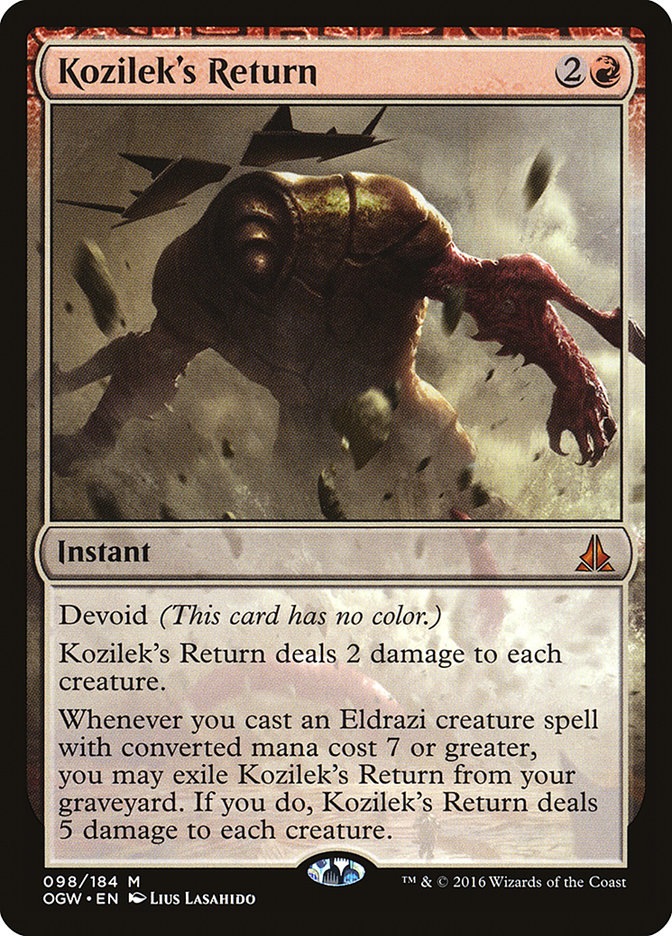Eldritch Moon is bursting with great cards! Brewers, Casual players, Commander players, and the world’s most prominent tournament winners are all exposing everything about how they feel about this set, and I love to be a part of that. My mind has been erupting with ideas ever since the spoiler started a couple of weeks ago, and for a small set, it has more awesome cards than it can hold. My fingers are swelling, too; I can’t contain my excitement! No, really, I can’t! My eyes are bulging, my skin is puffy, and I feel like I’m going to…blegghhhhhh…
Emerge is one of Eldritch Moon’s most exciting new mechanics. People have compared emerge to the rare “offering” mechanic, found only on a cycle of five Betrayers of Kamigawa cards like Patron of the Nezumi; this is a sound comparison and impressive due to their similarity yet complete flavor difference. Offering is willing and urgent, hence the ability to do so at instant speed, but emerge is involuntary and violent.
Like offering, emerge represents a sort of economy of scale; you get a mana reduction the more creatures you’re able to keep on the battlefield, and the creature you give up gives you a mana advantage. The more creatures you play, the more you’re able to leverage emerge and the more you stand to gain. Thus, emerge decks should be full of creatures. Makes sense, right?
Now, the tough part is picking the best emerge creatures and the best creatures that can propel them in that direction.
In a contest of most obscure sacrifice trigger, Foul Emissary might take the cake in a few years, but the Emissary is a great example of what kind of creature we’re looking for: one that has a relevant enters-the-battlefield and/or leaves-the-battlefield effect and is easy to cast, not requiring a large color commitment to allow consistency and flexibility.
The most powerful emerge card from Eldritch Moon is a bit debatable, but for the moment, let’s pick the splashiest.
Decimator of the Provinces is being touted as a cheaper Craterhoof Behemoth (factoring in the emerge cost as a reducer) and decried as a ten-mana win-more waste of time. My guess is it falls modestly in the middle, turning a humdrum battlefield stall into a horrifying alpha strike. I’m a bit torn; Tajuru Warcaller has the same effect (basically) for half the cast and repeatability, and except for a couple of my own brews, it’s not gone anywhere (though the otherwise vanilla 2/1 body for five is probably as much to blame).
With Decimator of the Provinces as our target of choice, we want to flood the battlefield with creatures to get the best boost possible once Decimator comes hurtling down. Sizing, therefore, is less important: quantity over quality. The bodies of the creatures we play don’t have to be huge, but their effects should be solid. With that in mind, I’d vote for a format-defining card that, in this case, provides an unusual function: ramp.
You’ll give up a lot less if you’re adding one creature to attack and one creature to emerge, especially when so many of these creatures have an extra battlefield trigger.
Green is the theme, and in the end, we still have to come up with triple green to play Decimator of the Provinces. Still, I think there’s room for a few cards outside the creature color.
While we’ll be a bit short on removal in just mono-green, black gives us a bit more depth and sustainability as well as an extra target, Distended Mindbender. While not as game-ending as Decimator of the Provinces, Distended Mindbender gives us excellent removal against most decks, hitting two cards in all but the fastest of decks.
Combined with other synergetic cards, let’s break out a new deck!
Creatures (32)
- 4 Fleshbag Marauder
- 4 Elvish Visionary
- 2 Liliana, Heretical Healer
- 2 Nissa, Vastwood Seer
- 4 Catacomb Sifter
- 4 Deathcap Cultivator
- 4 Duskwatch Recruiter
- 4 Decimator of the Provinces
- 2 Distended Mindbender
- 2 Foul Emissary
Lands (23)
Spells (5)
Sideboard

This has a lot of similarities with other B/G decks, but it sacrifices speed for power in the form of its emerge targets, which still don’t give up that much speed. Decimator of the Provinces will cost six at the most (nothing more than three mana), but if six mana ends the game, I’ll spend it. Bear in mind that, besides the emerge reduction, some two-drops act as three-drops. Duskwatch Recruiter, when flipped, still uses its front side’s converted mana cost, plus it reduces the cost of all creatures by one. Deathcap Cultivator, while incapable of hitting delirium in this deck, is better than Leaf Gilder or Beastcaller Savant, and it can add a mana to reduce the cost of an emerge spell.
Liliana, Heretical Healer likes the additional cost of emerge, giving her a no-nonsense way of flipping. Collected Company has always favored her, too, allowing her to enter the battlefield alongside Fleshbag Marauder, one of her favorite companions, and flip before untapping. Collected Company also lets you have “surprise” emerge. With no battlefield, you can add three temporary mana to your battlefield (or four in the case of Catacomb Sifter) for the purposes of emerge.
The sideboard is bent against aggressive decks where I need to trade cards more efficiently than my opponent, and Mockery of Nature is a great role-player, undoing Demonic Pacts and other shenanigan-producers. I like an extra Cryptolith Rite for non-sweeper decks, as it, combined with Duskwatch Recruiter, can recharge your hand. Vile Redeemer can create a team from ashes, granting you three emerge mana for that Decimator of the Provinces waiting in your hand.
This felt straightforward and potent, and while there was a lot of value, it didn’t do very well if the plan stumbled. Sweepers were a definite problem, and the mana cost of the non-emerge creatures proved limiting. Cryptolith Rite decks play creatures on the cheap, and it seems like they’re on to something.
Decimator of the Provinces might be one of the more potent choices for emerge, but my favorite emerge card is Elder Deep-Fiend.
From the moment I saw this card, I knew that this card was a beating.
That’s a lot of abilities on an instant creature that can cost two mana. 5/6. Tap any four permanents. You know I got my set pre-ordered. This was one of the first emerge cards spoiled, and it set the bar high.
Elder Deep-Fiend is more than flexible; this behemoth is a downright contortionist, creating plays out of thin air and putting immense pressure on your opponent or the planeswalkers he or she controls.
Emerge is powerful for another reason: Battle for Zendikar and Oath of the Gatewatch each contained several cards that interact with Eldrazi spells that cost seven mana or more. Emerge gives you a cheap way to trigger those effects, namely this little gem.
Figuring out ways to meaningfully trigger this effect is one of the main mini-games R/G ramp decks play against themselves, but now with emerge, you just need a decent-sized creature to get the ball rolling. You can sweep things early, rebuild your team quickly, and blow away your opponent with the Eldrazi cast. Can you imagine that play? They go for the alpha strike and assemble an awesome team. They cast the game-winner, but you respond by casting Elder Deep-Fiend, triggering your binned Kozilek’s Return. Sweep the team, tap their lands, and resolve a huge 5/6. If you have another Elder Deep-Fiend, it survives! Now what are they going to do?
Alongside other good builder Eldrazi, especially Matter Reshaper, Eldrazi Skyspawner, and Herald of Kozilek, there’s a good case for U/R Eldrazi, an archetype that, while good before Eldritch Moon, gets a new life and a new direction.
Creatures (18)
- 2 Drowner of Hope
- 3 Herald of Kozilek
- 1 Conduit of Ruin
- 4 Eldrazi Skyspawner
- 4 Matter Reshaper
- 3 Elder Deep-Fiend
- 1 Vexing Scuttler
Lands (23)
Spells (19)

Tentacles everywhere!
Eldrazi have impacted Standard at every turn, and this deck mashes some of the best of them together while incorporating one of our newest toys, Coax from the Blind Eternities.
Blue has always gotten weirdly specific tutors; see Eerie Procession, Mystical Teachings, Renowned Weaponsmith, and Trapmaker’s Snare. The precedent of blue searching for things isn’t anything new, and this goes one step further down Weird Road: searching in exile and outside the game. For those of you unfamiliar with the “Wish” cycle from Judgment, when you search “outside the game,” in a casual game it can be from anywhere you can reasonably and freely access; in the case of a tournament, you can get cards “outside the game” from your sideboard. Thus, this deck is full of Eldrazi, sideboard and all, and ways to get at them.
Matter Reshaper is a slam dunk for emerge; it does something great when it dies and it makes even the unwieldly cost of Elder Deep-Fiend manageable as early as turn 4. It dies to Kozilek’s Return, too, so no harm there. Eldrazi Skyspawner is just like Catacomb Sifter in the first deck, trading an easier casting cost and evasive quality for two points of toughness and the scry trigger. Together, it and its Scion reduce the emerge cost of the card of your choice by four!
Like Duskwatch Recruiter and Deathcap Cultivator, Herald of Kozilek reduces the cost of almost every spell in this deck, providing an additional mana in reduction for any emerge spells. Conduit of Ruin helps me find the best high-cost Eldrazi, plus it makes emerge much more impactful. With it out, you can eat an Eldrazi Skyspawner, pay UU, and have a shiny new 5/6 while they have no relevant untapped permanents. Pretty slick!
These decks were built to test the most exciting emerge cards in the format, but there’s certainly lots more combinations to work with, and each has tons of potential. I can assure you that there will be emerge cards in the Top 8 of #SCGCOL, and I want to be the one to say it first.
Comments from Last Week
Any suggestions on possible sideboard cards for week one in your Superfriends deck? I’m definitely going to try it out, but I was just wondering things it might need based on your playtesting.
– Jeremiah Julian
Last week, I discussed a Superfriends deck with eleven planeswalker cards. Even since the set has been fully spoiled, I haven’t changed anything. The deck still works like a charm, and it holds its own in aggressive and control matches. It’s just a lot of planeswalkers to answer. I recently tested against Collected Company, and in a long drawn-out game, I clinched a win, proving that when the best cards of Collected Company stack up against this deck, it still can’t get a win.
That being said, I’d keep the maindeck as it is. From a sideboard perspective, I considered a number of additions. I like Declaration in Stone for the more aggressive matches, and Dromoka’s Command has gotten a nudge from me as more of my friends brew with Demonic Pact and Harmless Offering. Another card I like? Veteran Warleader.
This deck has a surprising number of Allies between Oath of Gideon, Sylvan Advocate, and Gideon, Ally of Zendikar tokens, so Veteran Warleader will not only be large, it’ll be able to tap down and gain special abilities easily. In a deck that tends to stalemate, this might be one of the better combat-ready creatures you can have.
Spell Queller seems like another slam dunk; if they substitute out specific removal, Spell Queller can stuff those spells away for a long time until they’re no longer relevant.
My #SCGCOL sideboard for this deck?
3 Dromoka’s Command
2 Gaea’s Revenge
As much as it’s not really a brew, I just want to throw eldritch evolution into a B/G Cryptolith Rite deck and call it a day.
– Brian Hunt
Brian is on track. The popular B/G Rite decks got a big boost with Eldritch Evolution. You can use Scions to find Zulaport Cutthroats or eat a Blisterpod to get Liliana, Heretical Healer. You could push the Rite into bigger creatures, maybe helping you find the pieces to make the Brood Monitor deck work. Soon, though, you’d get to the point where you wouldn’t want Cryptolith Rite anymore, just four Collected Company and four Eldritch Evolution. I’m not saying it’s a bad thing; you get a lot more control over your creature plays that way.
There is so much in this set that’s got me exploding with ideas. What ideas have emerged in your head?


